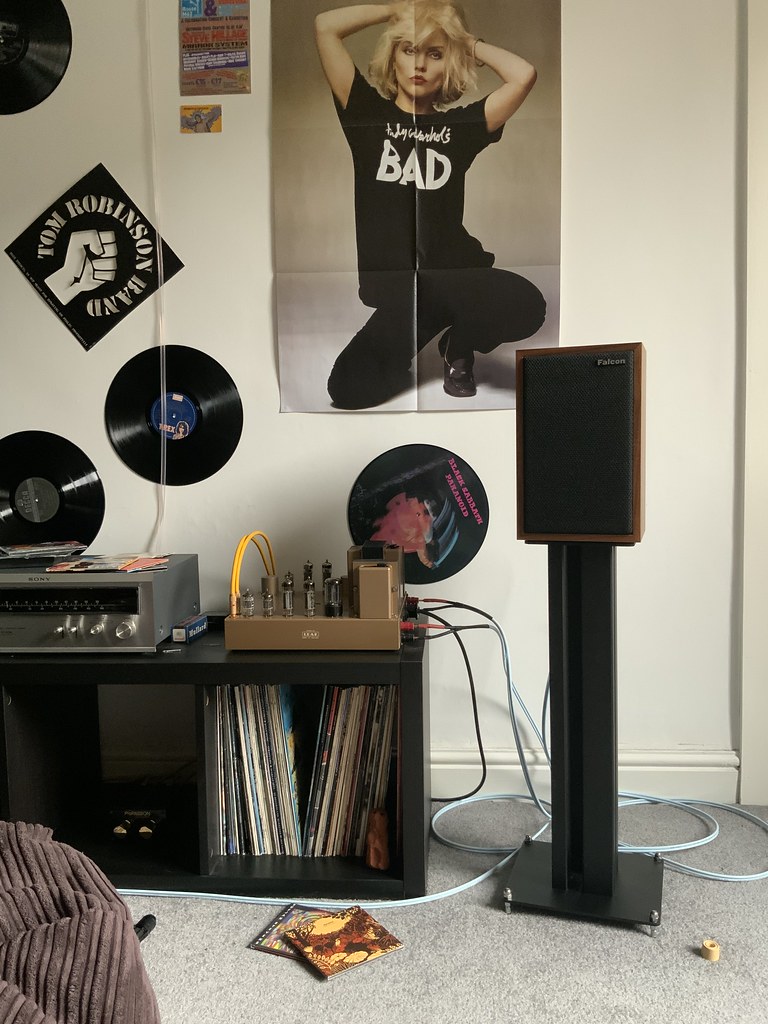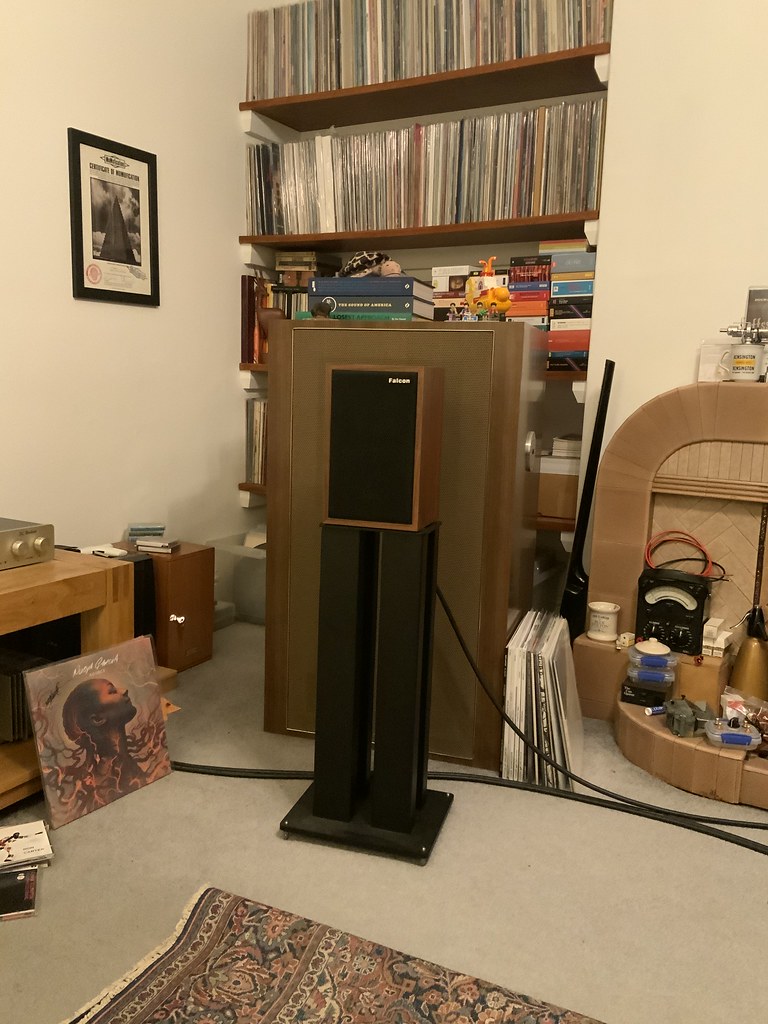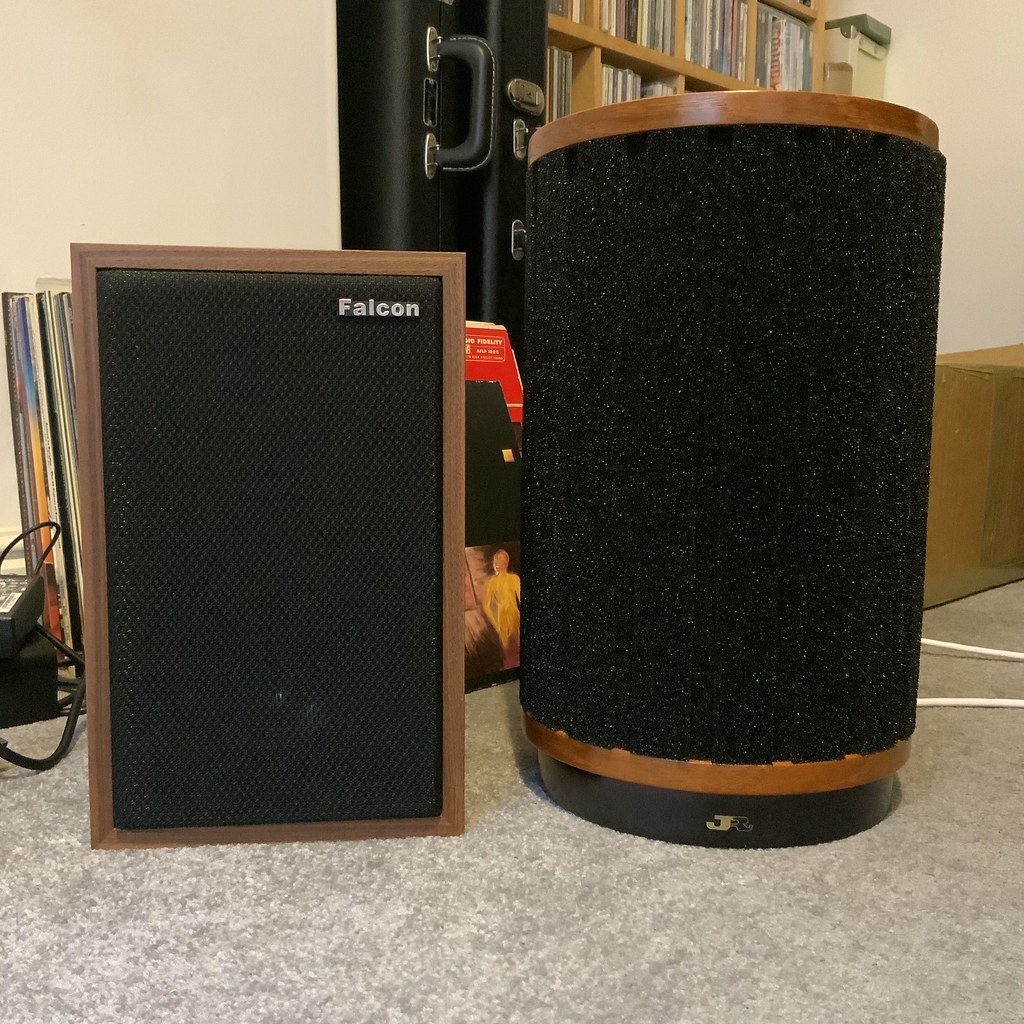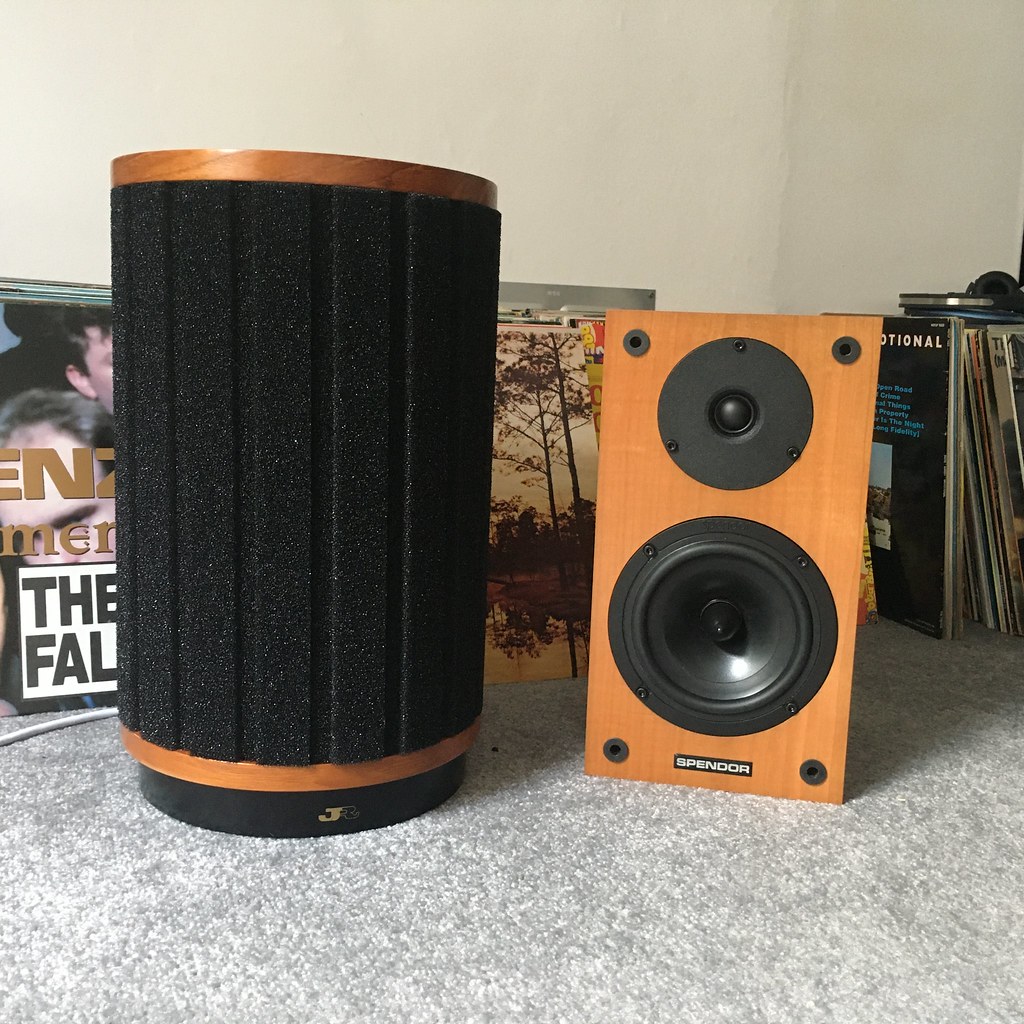Tony L
Administrator
Time to start rambling aimlessly about these little BBC monitors and I think it makes sense to do so on their own thread rather than cluttering up my ongoing JR149 thread. There will inevitably be some overlap and some comparisons to be made, but that will come later.

(pfm Record Shop system upstairs, hence ‘decor’!)
These are Falcons, so an accurate modern recreation of the original 15 Ohm LS3/5A. They are bog standard, i.e. do not have the new ‘gold label’ crossovers, so I am assuming they are just an LS3/5A. Nothing more, nothing less. There is a wonderful quote somewhere from the Eastern collector with a massive wall of the things saying being honest he can’t tell them apart as they all sound the same, which is what one would hope given it is a very precise spec. As such any content on this thread just assumes the Falcons are just an LS3/5A the same as any other 15 Ohm model. The stands are also by Falcon and I bought them as they are just more manageable and have a better sized top-plate than my Target R4s (which being honest I struggle to move let alone carry up/down stairs).
Anyway, I’m kind of shocked by the LS3/5As. They are seriously good speakers. I knew I liked them as I have done at shows etc, often feeling they were the best sound there, and I knew that the reason I liked them is they have that mid-band thing that is ‘right’ in the Quad ESL, and ‘wrong’ in so many other speakers regardless of size or price. What I wasn’t expecting is they actually sound pretty punchy too! They certainly don’t cower from a well recorded drum kit.

The bass is fascinating as that EQ bump actually works. They never end up sounding ‘small’ or ‘thin’, even in direct comparison with the Lockwoods. They have a little ‘warmth’ but none of the ‘flub’ or ‘hollowness’ of so many ported speakers (I do not like ports on small speakers). They are very easy to listen to across genres. The limitation is obviously there is a volume ceiling as there is with any mini-monitor, but in the nearfield at levels I like listening at they probably have enough range. They do seem to need a bit of volume to wake up, so I’m averaging around 80db on most stuff, which will certainly be putting the occasional peaks over 90db. That’s still within the scope of the Stereo 20 and obviously the 303 downstairs has no issue (and loves the 15 Ohm load).
I found some very interesting content on this Medialux blog theorising as to how the bass bump translates into a ‘win’ in the typically small rooms we have in the UK and I tried setting them up in exactly this way last night (i.e. not as pictured in the first pic on the thread, which is where the JR149s work) and it really works well. The theory being that you get them far enough from the back wall to negate the ‘bump’ but put them right on the 40Hz node present in the typical UK room and as the LS3/5A is so tight and well behaved down here, plus many db down, it uses it to its benefit. This certainly seems true; I was stunned by how well they did stuff like Donald Fagan’s Morph The Cat, the bass guitar deep, punchy and tight, the double bass and drums on Bill Evans Live At The Village Vanguard not diminished in stature at all. With the lights out there is no way in hell you would think a mini monitor was producing this soundscape. I guess this is also pretty much the position I had them in plonked in front of the Lockwoods on the R4s, where they actually worked remarkably well. I maybe need to rethink how I’m using the 149s in light of this and try a larger listening triangle.
When it comes to making any measurements and trying to form any conclusions between the three mini-monitors I have to hand things will obviously get a bit complex as they all have very different usage requirements, e.g. the JR149 does like some wall lift and sounds thin pulled right out into the room, and I suspect the Spendor S3/5R is somewhere in the middle ground between the two (though actually seems to work pretty much anywhere, they are currently on little tip-back Ikea stands either side of the TV and sound great!). As such there is likely no winner as they all have a slightly different installation context. I’m reluctant to make the classic reviewer/idiot mistake of measuring everything in the same place, but I’m not sure how useful comparisons of speakers in different locations are. What I would really like to measure is the time/phase domain as I’m pretty certain that is far more important to me as a listener than the odd bump or dip in a response curve. I tend to hear crossover points between drivers but not really care about the odd peak or trough as long as it isn’t a boom or honk.
I’m curious to see what any long-term LS3/5A users have to add. As with any speaker there is clearly an art to setting these things up and I’m certainly at the start of that learning curve.

(pfm Record Shop system upstairs, hence ‘decor’!)
These are Falcons, so an accurate modern recreation of the original 15 Ohm LS3/5A. They are bog standard, i.e. do not have the new ‘gold label’ crossovers, so I am assuming they are just an LS3/5A. Nothing more, nothing less. There is a wonderful quote somewhere from the Eastern collector with a massive wall of the things saying being honest he can’t tell them apart as they all sound the same, which is what one would hope given it is a very precise spec. As such any content on this thread just assumes the Falcons are just an LS3/5A the same as any other 15 Ohm model. The stands are also by Falcon and I bought them as they are just more manageable and have a better sized top-plate than my Target R4s (which being honest I struggle to move let alone carry up/down stairs).
Anyway, I’m kind of shocked by the LS3/5As. They are seriously good speakers. I knew I liked them as I have done at shows etc, often feeling they were the best sound there, and I knew that the reason I liked them is they have that mid-band thing that is ‘right’ in the Quad ESL, and ‘wrong’ in so many other speakers regardless of size or price. What I wasn’t expecting is they actually sound pretty punchy too! They certainly don’t cower from a well recorded drum kit.

The bass is fascinating as that EQ bump actually works. They never end up sounding ‘small’ or ‘thin’, even in direct comparison with the Lockwoods. They have a little ‘warmth’ but none of the ‘flub’ or ‘hollowness’ of so many ported speakers (I do not like ports on small speakers). They are very easy to listen to across genres. The limitation is obviously there is a volume ceiling as there is with any mini-monitor, but in the nearfield at levels I like listening at they probably have enough range. They do seem to need a bit of volume to wake up, so I’m averaging around 80db on most stuff, which will certainly be putting the occasional peaks over 90db. That’s still within the scope of the Stereo 20 and obviously the 303 downstairs has no issue (and loves the 15 Ohm load).
I found some very interesting content on this Medialux blog theorising as to how the bass bump translates into a ‘win’ in the typically small rooms we have in the UK and I tried setting them up in exactly this way last night (i.e. not as pictured in the first pic on the thread, which is where the JR149s work) and it really works well. The theory being that you get them far enough from the back wall to negate the ‘bump’ but put them right on the 40Hz node present in the typical UK room and as the LS3/5A is so tight and well behaved down here, plus many db down, it uses it to its benefit. This certainly seems true; I was stunned by how well they did stuff like Donald Fagan’s Morph The Cat, the bass guitar deep, punchy and tight, the double bass and drums on Bill Evans Live At The Village Vanguard not diminished in stature at all. With the lights out there is no way in hell you would think a mini monitor was producing this soundscape. I guess this is also pretty much the position I had them in plonked in front of the Lockwoods on the R4s, where they actually worked remarkably well. I maybe need to rethink how I’m using the 149s in light of this and try a larger listening triangle.
When it comes to making any measurements and trying to form any conclusions between the three mini-monitors I have to hand things will obviously get a bit complex as they all have very different usage requirements, e.g. the JR149 does like some wall lift and sounds thin pulled right out into the room, and I suspect the Spendor S3/5R is somewhere in the middle ground between the two (though actually seems to work pretty much anywhere, they are currently on little tip-back Ikea stands either side of the TV and sound great!). As such there is likely no winner as they all have a slightly different installation context. I’m reluctant to make the classic reviewer/idiot mistake of measuring everything in the same place, but I’m not sure how useful comparisons of speakers in different locations are. What I would really like to measure is the time/phase domain as I’m pretty certain that is far more important to me as a listener than the odd bump or dip in a response curve. I tend to hear crossover points between drivers but not really care about the odd peak or trough as long as it isn’t a boom or honk.
I’m curious to see what any long-term LS3/5A users have to add. As with any speaker there is clearly an art to setting these things up and I’m certainly at the start of that learning curve.



